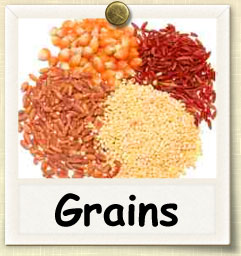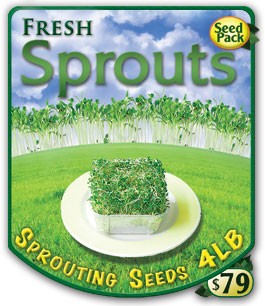|
Home > Guides > Sprouts > Grain Seeds |
|
How to Sprout Grain Seeds | Guide to Sprouting Grain Seeds |
|
|
| |
 |
|
Overview |
|
|
|
|
|
| |
|
| |
Grain sprouts are often used in breads, cereals and other dishes. Although grain sprouts are delicious in their own right, they are often sprouted not for taste but for improved digestibility. Types of grains commonly sprouted include corn, wheat, rice, millet and others. Some grains, such as wheat, are grown beyond the sprout stage into a grass stage to take advantage of their strong nutritional content. |
|
| |
|
|
| |
Growing Guide
GROWING NOTES
Unlike other types of spouts, sprouted grains are not typically eaten raw. While they are safe eaten raw immediately after sprouting (and may be called for in some recipes), they are often incorporated into cooked breads, cereals or other baked goods. The advantage of sprouting grains is increased digestibility. Seeds naturally contain growth inhibitors which are deactivated by the germination process. Sprouting seeds is believed to unlock the greater nutritional potential contained within, in addition to producing a live food source that more easily assimilated upon consumption.
Additionally, most grains can be sprouted successfully within 2-3 days or less. While other sprouts are enjoyed after the seed has germinated and the young stalk has undergone 4, 5 or more days of growth, grain sprouts are typically used earlier just as the young stalk has just begun to break through the seed coat.
Grain sprouts are sometimes dried for later use after germinating, depending upon specific requirements.
Procedure:
- To start your sprouts, you will want to soak your seeds in a bowl of cool water for 4-6 hours, or overnight, making certain that seeds are submersed and not floating on top of the water. This will soften the seed coat and promote germination. After soaking, thoroughly drain off all water. It is wise to rinse seeds immediately after soaking to clean them and wash away an extraneous matter, and again drain off all excess water.
- Wait several hours, then later in that day: Rinse seeds with cool, clean water. Carefully drain off all water so seeds at bottom of sprouter are not covered with water.
- Repeat this process of rinsing with cool water and draining 3-4 times per day as your seeds mature, and even as you begin to harvest and consume them. As your sprouts grow, it is important that they receive good air circulation. Many types of sprouters, such as simple canning jar types, provide good circulation with the tilting motion necessary for complete drainage. Keep your container on your kitchen table or counter, or similar location that has dependable lighting and airflow.
- Once sprouts have reached a desirable state for consumption, typically within 1-3 days for most grain sprouts, they can be transferred out of sprouter and placed under refrigeration to prolong their lifespan. This is not necessary but will slow down the growth process and give you a larger window to eat your sprouts. Sprouts should not be allowed to dry out, as they can quickly lose their vitality and nutritional content.
- Clean sprouter thoroughly after use.
|
|
| |
|
|
|
| |
|
|

|
|